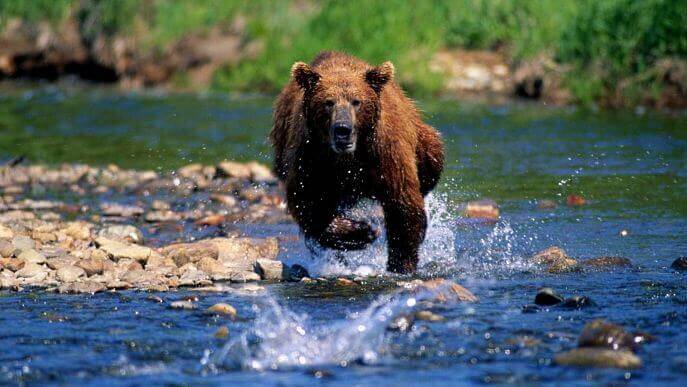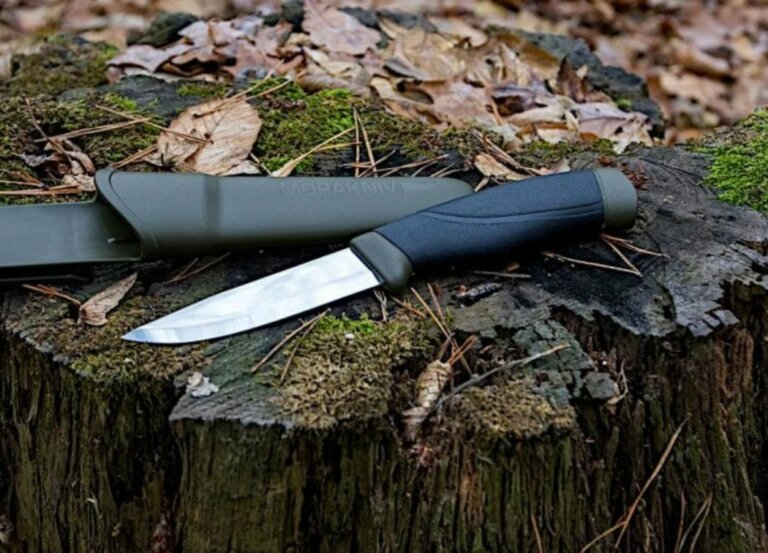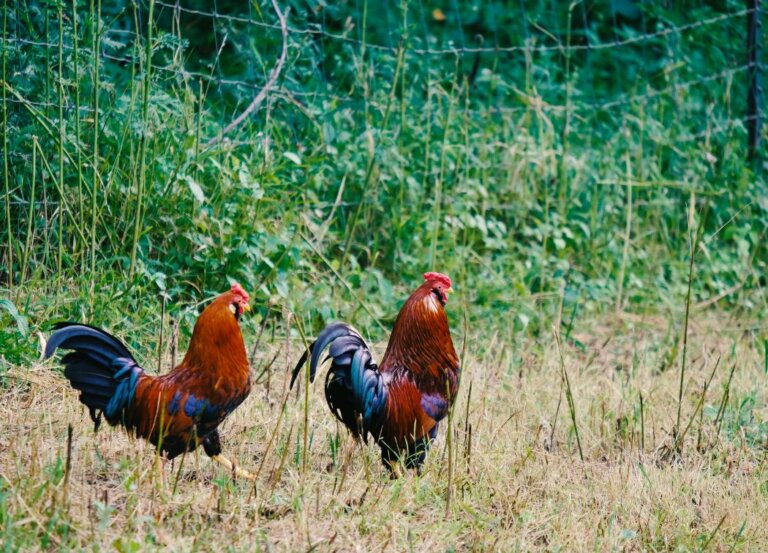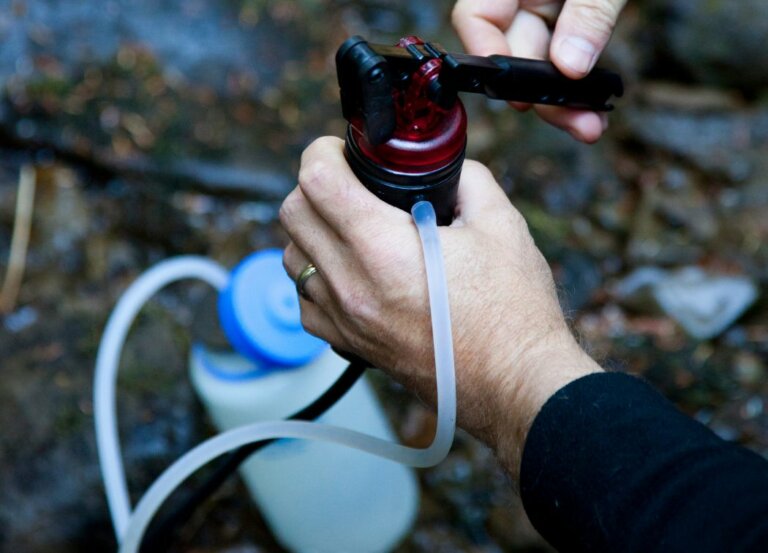So There’s A Bear In Front of You… What Now?
Imagine this: you’re out in the middle of a casual hike with your friends, enjoying a beautiful day in the great outdoors.
You stop to look around and admire the view, but something catches your eye – from a distance, clear as day, you see a bear looking straight back at you.
What do you do then?
Thoughts race through your head. Do you stand stock still, hoping that the bear will simply go away of its own volition? Or do you take a chance and stand aggressively, waiting for a fight?
Both decisions have their own merits, though it does help to know what kind of situation you’re in before resolve to take any action.
Here’s everything you need to know to get through a bear attack.

Understand What You’re Facing
As the old saying from Sun Tzu goes: “Know your enemy and know yourself and you can fight a hundred battles without disaster.”
Basically, by recognizing the species you’re up against, you’ll have a clearer idea on how they’ll respond and what you can do to keep yourself safe.

Now let’s cover that and talk bear types. North America sees three kinds of bears. The first is the black bear, a species that unfortunately does not live up to its name as it also often comes in shades of white, grey, and even brown. They’re the smallest of the three and are very common especially in the Canadian wilderness.
The second is the grizzly bear, alternatively called the North American brown bear. Named for their “grizzled” appearance – caused largely in part by the white-topped furs on their back and shoulders – these bears are notorious for size and stature. Like the black bears they’re found all over the continent too.
The last is the polar bear. As its name suggests, it can only be found in the frigid environments of the north where people are scarce. Characterized by their thick, light fur and their large, front feet, they roam the Arctic sea ice in search of seals and whales to eat.
How To Avoid An Encounter
Because you’re incredibly unlikely to find yourself up against a polar bear, let’s concentrate on black bears and grizzly bears instead.
One of the best things you can do to avoid bear attacks is simply to get away from bear territory altogether. However, if that’s truly not possible, then the next best thing would be for you to not tempt them to come near you. Here’s how:
- The more the merrier. There’s power in numbers. Travel with a large group of buddies and don’t be afraid of making noise once you’re outside. Talk loudly, laugh boisterously, and sing songs to your heart’s content; not only is it fun but it’ll alert surrounding bears of your presence. Doing so will keep them away.
- Observe your surroundings. Don’t expect the bear to always take the initiative when it comes to avoiding encounters. That said, stay on the lookout for signs that a bear might be nearby. Tracks and droppings make for good indicators. Also, don’t stay in areas bears are known to frequent, especially in locations where there’s an abundance of berries or stream banks.
- Store food safely. Never leave your food in easy to reach, unattended areas, especially when camping. According to the National Parks Conservation Association, the best way to keep food safe is to double-bag it and then hang it at least 14 feet from the ground. On the other hand, you could also keep your food in your car. Park it at least 100 yards away to be safe, just in case.
- Always bring bear spray. If you’re going into an area that might have any king of bears, always bring a high quality and proven bear spray. Do not rely on regular pepper spray either, make sure your bear repellent is rated for bears. Otherwise it isn’t going to do much good, and it will be way too late to find out. Only trust your life to the best bear spray on the market.
Surviving A Close-Up Encounter
How hibernation can change a bear’s decisions
Bears tend to make different decisions based on their internal clocks and what season it is, notably if it’s their hibernation time or not.
Bears should be hibernating by late fall, so if you encounter one roaming around it’s likely looking for a cozy place to stay, or possibly one last good meal before laying up for the winter. You would make an excellent dinner in such a case, or your shelter may look like a nice home, so expect the bear to make more aggressive decisions.
Alternatively, a bear coming out of hibernation is going to be very hungry, but at the same time it would prefer an easy meal. It’s energy is low and fighting for a hard won meal isn’t a first choice.
That’s not to say they won’t attack, especially if it is a female with cubs, because they will attack at any time and they might BECAUSE they are hungry, but generally speaking they would prefer other options.
Cubs make all the difference
Knowing when mama bear might have cubs with her is extremely important. Most cubs are born in early January, with mama usually giving birth to two or three blind and completely helpless cubs.
They nurse them in their den until spring, when they all emerge in search of food. By April the cubs are running around everywhere mama bear will allow. The cubs will stay with their very protective mother for about two years.
Every mama bear is famously aggressive if it’s cubs may be in danger, and unfortunately just your presence in the same area is seen as a threat.
Identify the bear
If you somehow end up in a close encounter anyway – one where both you and the bear are at an uncomfortable proximity – then here’s where knowing what bear you’re up against becomes useful.

Here are some of the key physical indicators you can look out for when trying to discern between a black or a grizzly bear:
- Their shoulder humps: Grizzly bears have large, muscular shoulder humps while blacks do not.
- The fur on their shoulders: Grizzly bears have white-topped fur on their shoulders.
- The size of their ears: Grizzly bears’ ears are short and rounded while black bears’ are tall and almost triangular.
- The shape of their nose: Grizzly bears have blunt and slightly rounded noses while black bears’ are more pointed.
Deal with the immediate threat
Should a black bear start getting too close, then don’t ignore it! Instead, slowly turn your body towards it and look it in the eyes. Verbally inform it that you are not a threat in a calm but authoritative tone.
Then, slowly back away, maintaining your gaze on the bear. In most cases, the bear will flee at this point. Make sure to give it space to do so.
If it decides to come closer, though, then stand your ground and ready your bear spray. Keep one hand on your bear spray and the other hand on your gun or knife.
Keep up eye contact, make yourself look as big as possible, and strictly tell it to leave. You can even yell, “Go away, bear!” Be careful not to get frantic though, as that could provoke the bear into attacking.
On the other hand, if you find yourself faced with a grizzly bear, treat it differently. For one, do not make eye contact with it. Don’t make any sudden movements either. When speaking to it, use a calm, monotone voice and never give it a reason to engage you. Appear non-threatening.
After that, if the bear is at a standstill, then back away slowly as you would with a black bear. If it continues to approach, then deter it any way you can without resorting to anything that could scare and ultimately provoke it. Spray it with your bear spray as a last resort, because sometimes it will scare the bear into charging.
Keep in mind that grizzly bears are more aggressive, so it may take longer to get them to back down.
Surviving The Attack
There are two main types of bear attacks: defensive attacks and predatory attacks.
Defensive attacks
Bears don’t want to fight any more than you do, but if they feel like they are being threatened then they will strike. This is especially true if they’re trying to protect their young or their food cache.
You’ll know that they’re only trying to defend themselves when they do things like swat the ground with their front paws, snort, or fake-lunge to try to get you to leave. The best thing you can do at this point is to remain calm and still so you can eventually back away.

If it decides to go on with its charge, then spray it with bear spray. If it continues, the moment it makes contact with you, drop down and play dead stomach side down.
Don’t even try to outrun it – bears can cover great distances within small amounts of time and are sure to be able to catch up with you. They are MUCH faster than humans.
Once on the ground, Make sure to interlock your fingers and place your hands above your nape, protecting your neck. Spread your legs and elbows out too so that the bear will encounter resistance when trying to flip you over.
Once the bear assesses that you are harmless and lets up, wait until it’s completely gone before you start to move again. To be safe, wait a minimum of half an hour or more.
Predatory attacks
Attacks like these aren’t meant to deter, but to kill, usually for food. Most bears do not see humans as prey, and these types of attacks are rarer, but certainly are not out of the question around hungry bears.
Sometimes it will be obvious to an expert that this bear is different in his actions, but your average person probably will not be able to tell until it is too late. Don’t wait around for positive signs this way or that, because what is thought to be a normal defensive bear could quickly charge for his next meal (you).
The bear may stalk you, circle around, or simply charge you from a distance. It depends on the terrain, the bear, and his attitude of the day. He may still try to intimidate you, but he will be more aggressive if you yell or try to intimidate him, and will follow you if you back away. He has no intentions of leaving.
The best thing to do should you find yourself in this situation is to simply fight for your life aggressively. Give it all you got. Spray it with bear spray, hit its sensitive spots, such as its eyes, nose, and mouth.
Use anything at your disposal, including knives, and don’t be afraid to overpower the bear. A gun may be the only thing that saves your life against a predatory bear.
Final Thoughts
Surviving a quick bear encounter can be fairly simple as long as you are able to keep calm in the face of danger. If a bear does decide to attack, you may still be able to scare it off with bear spray, or it may quit after only a few moments and leave.
If all else fails and you find yourself facing a predatory or aggressive bear that will not back down, preparing ahead of time will save your life. In those situations a gun may be your only option.






